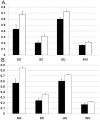Bacterial communities of the coronal sulcus and distal urethra of adolescent males
- PMID: 22606251
- PMCID: PMC3350528
- DOI: 10.1371/journal.pone.0036298
Bacterial communities of the coronal sulcus and distal urethra of adolescent males
Abstract
Lactobacillus-dominated vaginal microbiotas are associated with reproductive health and STI resistance in women, whereas altered microbiotas are associated with bacterial vaginosis (BV), STI risk and poor reproductive outcomes. Putative vaginal taxa have been observed in male first-catch urine, urethral swab and coronal sulcus (CS) specimens but the significance of these observations is unclear. We used 16 S rRNA sequencing to characterize the microbiota of the CS and urine collected from 18 adolescent men over three consecutive months. CS microbiotas of most participants were more stable than their urine microbiotas and the composition of CS microbiotas were strongly influenced by circumcision. BV-associated taxa, including Atopobium, Megasphaera, Mobiluncus, Prevotella and Gemella, were detected in CS specimens from sexually experienced and inexperienced participants. In contrast, urine primarily contained taxa that were not abundant in CS specimens. Lactobacilllus and Streptococcus were major urine taxa but their abundance was inversely correlated. In contrast, Sneathia, Mycoplasma and Ureaplasma were only found in urine from sexually active participants. Thus, the CS and urine support stable and distinct bacterial communities. Finally, our results suggest that the penis and the urethra can be colonized by a variety of BV-associated taxa and that some of these colonizations result from partnered sexual activity.
Conflict of interest statement
Figures







References
-
- Chang JY, Antonopoulos DA, Kalra A, Tonelli A, Khalife WT, et al. Decreased diversity of the fecal Microbiome in recurrent Clostridium difficile-associated diarrhea. J Infect Dis. 2008;197:435–438. - PubMed
-
- Eckburg PB, Relman DA. The role of microbes in Crohn’s disease. Clin Infect Dis. 2007;44:256–262. - PubMed
Publication types
MeSH terms
Substances
Grants and funding
LinkOut - more resources
Full Text Sources
Medical

